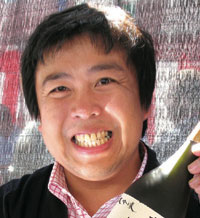Sake Nation “Sake Brewery Tourism”
By Kosuke Kuji
Approximately 36 million foreign tourists visited Japan last year.
Since Japan’s population is approximately 120 million, the number of foreign tourists to Japan last year was comparable to nearly a quarter of Japan’s population.
The Japanese government is currently working with the Japan Tourism Agency and tourism associations in various regions to recommend “Sake Brewery Tourism” to foreign tourists.
The Japan Council for Promotion of Sake Brewery Tourism was launched, and many supportive sake breweries are joining nationwide.
Of course, All Japan News, Inc. is also a corporate member.
Iwate prefecture partnered with Japan Railways Group (JR) and launched the “Discover Iwate” campaign from September 1 to November 30.
https://x.gd/CWtQN
A photo of a kura-style sake brewery used by Nanbu Bijin for 200 years was used in the poster for this campaign, visible in the shortened URL above.
Visitors can wear a happi coat (uniform of a sake brewery), tie a Japanese hand towel around your head, and cosplay as a sake brewery worker to take this same photo while touring the sake brewery.
This photo will commemorate your visit to the brewery. The photo can be taken right away on site and can also be downloaded to your smartphone. Visitors can also create labels using their photo and purchase them as a product. This original sake was also awarded the Minister of Land, Infrastructure, Transport and Tourism Commendation.
I highly recommend our readers to enjoy Sake Brewery Tourism when visiting Japan. Not only can you enjoy delicious sake, but you can also enjoy scenic views of rural Japan.
Since Japan’s population is approximately 120 million, the number of foreign tourists to Japan last year was comparable to nearly a quarter of Japan’s population.
The Japanese government is currently working with the Japan Tourism Agency and tourism associations in various regions to recommend “Sake Brewery Tourism” to foreign tourists.
The Japan Council for Promotion of Sake Brewery Tourism was launched, and many supportive sake breweries are joining nationwide.
Of course, All Japan News, Inc. is also a corporate member.
Iwate prefecture partnered with Japan Railways Group (JR) and launched the “Discover Iwate” campaign from September 1 to November 30.
https://x.gd/CWtQN
A photo of a kura-style sake brewery used by Nanbu Bijin for 200 years was used in the poster for this campaign, visible in the shortened URL above.
Visitors can wear a happi coat (uniform of a sake brewery), tie a Japanese hand towel around your head, and cosplay as a sake brewery worker to take this same photo while touring the sake brewery.
This photo will commemorate your visit to the brewery. The photo can be taken right away on site and can also be downloaded to your smartphone. Visitors can also create labels using their photo and purchase them as a product. This original sake was also awarded the Minister of Land, Infrastructure, Transport and Tourism Commendation.
I highly recommend our readers to enjoy Sake Brewery Tourism when visiting Japan. Not only can you enjoy delicious sake, but you can also enjoy scenic views of rural Japan.
酒豪大陸「酒蔵ツーリズム」
日本にはインバウンドで昨年は3600万人近い外国人が観光に来てくれました。
日本の人口は1億2000万人くらいなので、一年で日本の人口の1/4近くの人が日本に来てくれている、という事になります。
そんな、外国人観光客に向けて、今日本政府と観光庁、そして各地の観光協会と酒蔵では「酒蔵ツーリズム」を推奨しています。
日本酒蔵ツーリズム協会という団体も立ち上がり、日本全国から多くの賛同する酒蔵が加盟しています。
当社も当然参加していますが、そんな中で、岩手県は9月1日から11月30日まで「旅せよ岩手」キャンペーンをJRと組んでやっています。
https://x.gd/CWtQN
このキャンペーンのポスターに南部美人の200年前から使われる土蔵の酒蔵の写真が使われました。上記の短縮アドレスから見ることが出来ます。
酒蔵の象徴でもある「はっぴ」を来て、頭には南部美人のオリジナル和手ぬぐいをまいて、まさに蔵人にコスプレしたような形で見学し、このポスターと同じ写真が撮影できます。
まさに「酒蔵に行ってきました」という写真です。この写真はその場ですぐにこの写真はスマホにダウンロードできます。さらにこの写真をその場でオリジナルラベルにして商品として買う事も出来ます。このオリジナル酒は昨年の国土交通大臣表彰もいただきました。
是非この記事を見ている皆さんも日本に来たら全国へ酒蔵ツーリズムしに行ってください。最高に美味しい日本酒を飲むことが出来ますし、地方の素晴らしい美しい景色を見ることが出来ます。
日本の人口は1億2000万人くらいなので、一年で日本の人口の1/4近くの人が日本に来てくれている、という事になります。
そんな、外国人観光客に向けて、今日本政府と観光庁、そして各地の観光協会と酒蔵では「酒蔵ツーリズム」を推奨しています。
日本酒蔵ツーリズム協会という団体も立ち上がり、日本全国から多くの賛同する酒蔵が加盟しています。
当社も当然参加していますが、そんな中で、岩手県は9月1日から11月30日まで「旅せよ岩手」キャンペーンをJRと組んでやっています。
https://x.gd/CWtQN
このキャンペーンのポスターに南部美人の200年前から使われる土蔵の酒蔵の写真が使われました。上記の短縮アドレスから見ることが出来ます。
酒蔵の象徴でもある「はっぴ」を来て、頭には南部美人のオリジナル和手ぬぐいをまいて、まさに蔵人にコスプレしたような形で見学し、このポスターと同じ写真が撮影できます。
まさに「酒蔵に行ってきました」という写真です。この写真はその場ですぐにこの写真はスマホにダウンロードできます。さらにこの写真をその場でオリジナルラベルにして商品として買う事も出来ます。このオリジナル酒は昨年の国土交通大臣表彰もいただきました。
是非この記事を見ている皆さんも日本に来たら全国へ酒蔵ツーリズムしに行ってください。最高に美味しい日本酒を飲むことが出来ますし、地方の素晴らしい美しい景色を見ることが出来ます。




